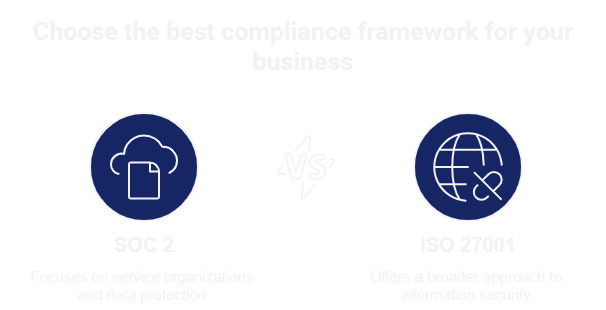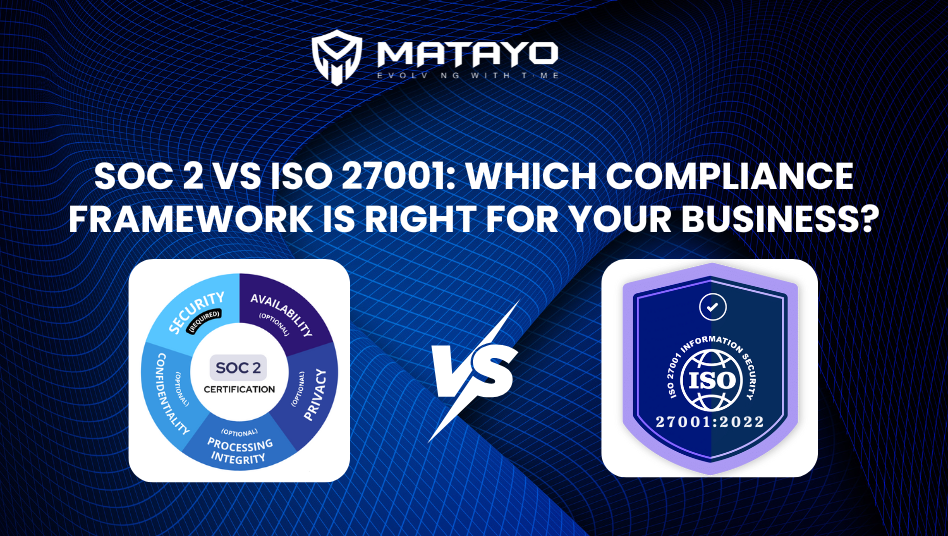The significance of data security has become crucial in the current digital world with the establishment of mandatory financial, legal, and reputational risk management strategies. These strategic protocols are aligned with data breaches and degrading consumer trust. However, both the SOC 2 framework and ISO 27001 legal protocols are increasing their interconnectivity to facilitate data sharing and develop mitigation strategies against complex cyber threats, thereby establishing a strategic security protocol and data regulation. These are the necessary protocols for every organisation to handle confidential information. The optimisation of new technologies, the upgrade of digital infrastructure, and increasing international politics are responsible for the rise in cyber attacks and legal demands.

What are SOC 2 and ISO 27001?
Organisations are facing increasing pressure to protect sensitive data and demonstrate robust security practices. SOC 2 and ISO 27001 are the two leading security compliance frameworks that work diligently to provide the utmost security to businesses.
SOC 2, also known as System and Organisation Control, is a regulatory standard compliance developed by the AICPA. Initially, it was designed for service providers, particularly those responsible for managing customer data in cloud offices or those offering reliable solutions. SOC 2 focuses on five Trust Service Criteria: security, availability, integrity, confidentiality, and privacy. It is a certified AICPA organisation responsible for conducting rigorous audits to evaluate whether the company’s controls meet the enterprise’s distinctive criteria. The SOC 2 reports are assessed and accredited in the USA, providing customers with assurance that their data is managed securely and that the company is following all industry-standard protocols.

SOC 2 regulatory compliance is of two types: Type 1 evaluates legal controls for a specific period, whereas Type 2 examines security controls over a period of approximately 10 to 12 months. Conversely, ISO 27001 is an internationally adopted and recognised security compliance framework that develops, implements, and improves information security protocols. International Security compliance committees regulate this legal certification, making it suitable for various companies worldwide that serve global clients.
SOC 2 is an audit report primarily optimised by service providers to assess the effectiveness of their customers’ data security. Besides customer security, ISO 27001 is a management framework that focuses on a holistic, process-based approach to maintaining security compliance. Based on client adaptability and legal protocols across different nations and organisations, businesses are required to choose either one particular legal framework or both, thereby attaining various benefits. Many organisations use both ISO 27001 to improve internal processes and SOC 2 to provide transparency for client assurance.
Similarities between SOC 2 audit and ISO 27001 compliance
Both of these legal regulatory compliances ensure strategic information security and build trust with customers. Both frameworks in global companies apply a structured set of controls for data protection and risk mitigation. The focus of risk management requires daily identification, evaluation, and mitigation of security threats. Documentation and regulatory policies are essential in both frameworks, as companies need to maintain a track record of successful process controls and security management. Additionally, external parties are involved in auditing the basic assessment of this framework, including CPAs that certify SOC 2. For ISO 27001, globally authorised certification bodies are regulated. Both of these frameworks are flexible and ideal for organisations of varying volumes and industries, from small SaaS providers to large enterprises, providing reassurance about their adaptability.
Differences between SOC 2 audit and ISO 27001 compliance

Indeed, there are multiple similarities between these two efficient security frameworks, but there are notable differences that need to be understood. SOC 2 is initially audit-driven to assess five trust service criteria, which have been broadly adopted in the United States of America, especially for those businesses that have already adopted SaaS regulations and cloud services. The AICPA accredits the SOC 2 framework, whereas the ANSI-ASQ National Accreditation Board authorises the ISO 27001 standard. ISO 27001 is a management-focused framework that emphasises the development of information security management systems. It is globally approved, making it ideal for international operations, whereas SOC 2 reports are designed for clients, ensuring the effectiveness of the security controls in place. ISO 27001 certification enables continuous compliance with structured security requirements. The result of the SOC 2 audit report is available under NDA, and reports do not become invalid; clients usually require surveillance every year. The ISO 27001 regulatory report is readily available for public review, and monitoring audits are conducted every three years, with recertification needed after this period. The time frame for a Type 1 SIC 2 audit is approximately 4 months, whereas for Type 2, it is around 12 months, and for ISO 27001, it is within 10 to 12 months.

Factors determining a comprehensive security framework for businesses

The selection of the proper audit control framework, which utilises either SOC 2 or ISO 27001, is a pivotal decision that impacts the credibility, operational efficiency, and consumer trust of the organisation. The role of these auditory complaints is essential, and factors that contribute to them need to be considered when making any crucial decision regarding security complaints. To combat increasing digital risk, both SOC 2 and ISO 27001 have been recognised as the top regulatory frameworks for maintaining a rigorous security protocol across various industries, thereby building consumer trust and enhancing the company’s legal posture.
● Customer base and location
It is pivotal to know the target customer base for a seamless journey. SOC 2 has gained popularity in America, particularly among business clients that have adopted SaaS regulations and cloud services. If your organisation has US-based clients or enterprises that demand a vendor audit, then SOC 2 compliance can provide security assurance. ISO 27001 has worldwide recognition, making it ideal for companies with a global client base. Organisations serving customers across Europe, Asia, or international corporations can prefer ISO 27001 to regulate information security practices and meet the credible expectations of multiple nations’ security protocols.
● Industry requirements
Industry-specific regulations often direct the adoption of a framework. Due to the focus on data security and client trust, Fintech, healthcare, and cloud service providers must meet SOC 2 requirements. ISO 27001 is occasionally adopted by organisations in the consulting, IT, Telecommunications, government, and manufacturing sectors, where the information security management system is highly accredited. ISO 27001 provides a compliance level that leverages a marketing advantage, reduces organisational security expenses, and brings order to the business. Therefore, completing the industrial compliance landscape helps to avoid the gap in legal adherence and position the organisation as a reliable partner.
● Stage of business
The maturity of the organisation affects the regulatory compliance approach. Startups initially can pursue SOC 2 type 1 evaluation at a specific time period, providing quick client assurance without an extensive internal process. Mature organisations with developed operations can opt for ISO 27001 for implementing a strategic ISMS to support continuous improvement and prolonged security practices. The stage of the business determines not only the complications of implementation but also the time investment required for authentic and effective compliance. Companies from all these industries store millions of private confidential data points, which are SOC 2 certified, reassuring consumers that their financial and personal information will not be disclosed. This certification helps demonstrate rigorous data protection measures to keep confidential documents safe at every stage of the business.
● Budget and resources
Financial and human resources are essential for both SSC and ISO 27001 security compliance, but their scope is not identical. Similar to ISO 27001, it requires a comprehensive internal environment that includes risk evaluation, development of a security management system, process documentation, training, and continuous maintenance. However, SOC 2 audits are consistently focused on specific controls, making them less research-intensive, especially for entrepreneurs. The assessment of the available budget, team capacity, and expertise ensures that the optimised framework can be efficiently applied without overloading the company.
● Long-term goals
A business’s long-term strategy is to shape regulatory compliance in response to increased security breaches and upgrades to its digital infrastructure. ISO 27001 establishes a framework for ensuring information security in systems that aligns with both global and regional security regulations, such as the GDPR and HIPAA. It focuses on building a culture of development and maintaining internal corporate governance, whereas a SOC 2 audit fosters building client reliability within a short timeframe. Many companies have already adopted both ISO 27001 and its associated framework to control internal governance protocols through external audit reporting, aiming to achieve a strategic balance between operational reliability, continuous improvement, and market-based requirements.

Conclusion
The implementation of SOC 2 and ISO 27001 depends on the business context, client trust, and long-term vision of the organisation. SOC 2 is highly efficient for SaaS and technology provider-based businesses that require control efficiency for American-based clients. It is often an easier and faster option for startups or service providers that require immediate credibility with customers who demand evidence of secure data management. Conversely, ISO 27001 provides an internationally recognised systematic framework for establishing an information security management system, which is valuable for companies dealing with global clients, making long-term strategic commitments, and facing significant regulatory exposure, thereby building a strategic information security governance framework. The implementation of this framework required continuous development and business resilience. Matayo implements both of these frameworks to achieve better outcomes, as ISO 27001 enhances internal processes and risk management, while the various SOC 2 frameworks provide transparent market-based trustworthiness.

